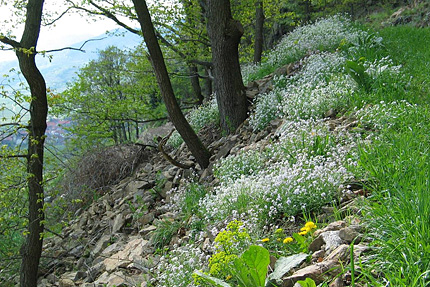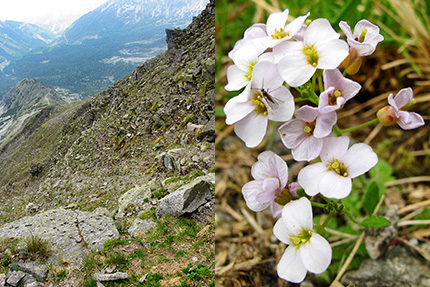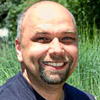Adaptation and introgression: Habitat adaptation and the acquisition of adaptive traits via introgression in an Arabidopsis lyrata - arenosa introgression zone
Project code: KO 2302/14-1

Arabidopsis arenosa population in open and dry oak forest in the Wachau region close to the Danube river (Austia).
In the Alps, there is a clear distinction between calcicole species and vegetation found on alkaline bedrock. This differentiation contributes substantially to the diversification of the Alpine flora during Pleistocene glaciation and deglaciation cycles. However, we remain largely ignorant about the underlying genetic basis of this adaptation. In Arabidopsis, one such example of this calcicole/calcifuge differentiation in the Alps is illustrated by a hybrid zone found in Eastern Austria between Arabidopsis lyrata X A. arenosa. Between the Austrian eastern Forealps, dominated by calcareous bedrock, and the Bohemian massif in the north, largely dominated by siliceous bedrock, there is a major introgression zone between these two species. This suture zone covers approximately 900 km² and is located in the Wachau region where the Danube River breaks through the Bohemian massif. Previously, we have unraveled introgression from A. arenosa into A. lyrata (in this zone) with subsequent migration of the newly formed and cytogenetically fully stabilized tetraploid northwards into the Wachau. These analyses have been conducted at the population level with more than 120 populations and 2500 individuals (using chloroplast and ITS sequences, microsatellites, multivariate analysis of morphometric data, cytological data and breeding system experiments). Based on all of these data we postulate that diploid A. lyrata was introgressed by tetraploid A. arenosa in the limestone East Forealps. The resulting "hybrid" became stable cytogenetically at the tetraploid level, and obtained the ability to escape from the narrow ecological niche of A. lyrata. The introgressed individuals/populations migrated north, most likely following the rivers draining into the Danube River ("Traisen Linie"), and entered the Wachau area where they are nowadays growing on siliceous bedrocks and gravel.
The goals of the project are to identify genomic footprints indicating the adaptation to ecological conditions, e.g. soil type, and to test the hypothesis that hybridization followed by introgression of these adaptive genes from an adapted into a non-adapted gene pool has allowed introgressed individuals to colonise a new habitat.

Alpine Arabidopsis arenosa var. intermedia on silicious bedrocks in Eastern Austria (Seckauer Tauern)
Publications related to the project
- Hohmann N, Wolf EM, Lysak MA, Koch MA (2015) A
Time-Calibrated Road Map of Brassicaceae Species Radiation and
Evolutionary History. The Plant Cell. 2015 Sep 26. pii: tpc.15.00482.


- Muir G, Ruiz-Darte ., Hohmann N, Mable B, Novikova P, Schmickl R, Guggisberg A, Koch MA (2015) Exogenous selection rather than cytonuclear incompatibilities shapes asymmetrical fitness of reciprocal Arabidopsis hybrids. Ecology & Evolution, doi: 10.1002/ece3.1474 (2015)

- Hohmann Nora, Schmickl R, Chiang T-Y, Lucanova M, Kolar F, Marhold K, Koch M.A. (2014) Taming the wild: resolving the gene pools of non-model Arabidopsis lineages. BMC Evolutionary Biology 14:e224.


- Schmickl R, Paule J, Klein J, Marhold K, Koch MA The evolutionary history of the Arabidopsis arenosa species complex: Highly diverse tetraploids mask that the Western Carpathians are the center of species and genetic diversity. PLoS One 7(8):e42691 (2012).


- Jorgensen MH, Ehrich D, Schmickl R, Koch MA, Brysting A Interspecific and interploidal gene flow in Central European Arabidopsis (Brassicaceae). BMC Evolutionary Biology 11: e346. doi:10.1186/1471-2148-11-346 (2011).


- Schmickl R, Koch MA Arabidopsis hybrid speciation processes. Proceedings of the Natural Academy of Sciences, USA 108 (34): 14192-14197 (2011).







